
|
It brightened up to 7.8 mag in late July (July 20, Thomas Lehmann). Now it is 9.4 mag (Aug. 11, Chris Wyatt). It will fade out rapidly after this. It will be unobservable in October. But it will be observable again in December in the Northern Hemisphere.
Date(TT) R.A. (2000) Decl. Delta r Elong. m1 Best Time(A, h)
Aug. 12 15 20.61 -29 14.1 0.986 1.492 96 9.2 20:25 ( 33, 17)
Aug. 19 15 5.97 -24 18.0 1.199 1.506 85 9.7 20:15 ( 42, 17)
|
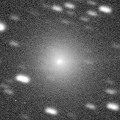
|
Bright new comet. It will approach to Sun down to 0.22 a.u. in mid September, and it is expected to brighten up to 2 mag. Now it is 9.2 mag (Aug. 16, Jakub Cerny). It will turn to fade out rapidly after brightening. It will be unobservable in September. But it will be observable again in October in the Southern Hemisphere.
Date(TT) R.A. (2000) Decl. Delta r Elong. m1 Best Time(A, h)
Aug. 12 7 5.75 18 45.4 1.736 1.049 33 10.4 3:43 (254, 10)
Aug. 19 7 28.02 20 22.3 1.516 0.898 34 9.4 3:51 (254, 13)
|

|
Now it is 9.8 mag (July 29, Marco Goiato). Fading gradually. In the Northern Hemisphere, it will be getting lower gradually. In the Southern Hemisphere, it stays observable in good condition.
Date(TT) R.A. (2000) Decl. Delta r Elong. m1 Best Time(A, h)
Aug. 12 3 5.40 0 10.1 2.184 2.480 94 9.6 3:43 (314, 45)
Aug. 19 2 59.79 -3 34.3 2.083 2.516 103 9.6 3:51 (329, 47)
|
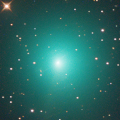
|
It brightened up to 8.4 mag in late July (July 22, Thomas Lehmann). Now it is 9.4 mag (Aug. 12, Osamu Miyazaki). It will fade out rapidly after this. It will be fainter than 18 mag in November. In the Northern Hemisphere, it stays observable in good condition. In the Southern Hemisphere, it will be getting higher gradually.
Date(TT) R.A. (2000) Decl. Delta r Elong. m1 Best Time(A, h)
Aug. 12 21 31.65 48 46.1 0.384 1.231 116 9.8 0:12 (180, 75)
Aug. 19 21 45.18 34 34.1 0.375 1.295 132 10.2 0:00 ( 0, 88)
|

|
It will approach to Sun down to 0.05 a.u. on Aug. 21, and it will brighten up to 5.5 mag. It will turn to fade out rapidly after brightening. It will be fainter than 18 mag in September. In the Northern Hemisphere, it will never be observable after this. In the Southern Hemisphere, it will be unobservable soon.
Date(TT) R.A. (2000) Decl. Delta r Elong. m1 Best Time(A, h)
Aug. 12 10 45.29 1 35.7 0.827 0.425 24 14.8 20:25 (101,-12)
Aug. 19 10 4.04 10 18.0 0.885 0.145 4 10.2 20:15 (118,-18)
|

|
It is expected to brighten up to 7.5 mag in October. Now it is 11.6 mag (Aug. 14, Juan Jose Gonzalez). Brightening rapidly. In the Northern Hemisphere, it stays observable in good condition. It locates somewhat low in the Southern Hemisphere. But it will become high in autumn.
Date(TT) R.A. (2000) Decl. Delta r Elong. m1 Best Time(A, h)
Aug. 12 0 50.28 34 45.9 0.605 1.348 110 11.2 3:30 ( 0, 90)
Aug. 19 1 22.72 38 2.6 0.544 1.295 108 10.6 3:35 (180, 87)
|

|
It brightened up to 8 mag from 2022 summer to 2023 spring. Now it is 11 mag (July 15, Michael Mattiazzo). It stays 12 mag for a while. In the Northern Hemisphere, it will be getting higher gradually. In the Southern Hemisphere, it stays observable in good condition.
Date(TT) R.A. (2000) Decl. Delta r Elong. m1 Best Time(A, h)
Aug. 12 6 35.21 -8 37.6 3.922 3.334 48 11.7 3:43 (281, 1)
Aug. 19 6 39.37 -8 26.4 3.923 3.398 52 11.8 3:51 (285, 7)
|
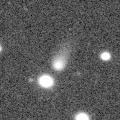
|
It is expected to brighten up to 7 mag in early 2024. Now it is 14.1 mag (June 19, Chris Wyatt). It will brighten rapidly after this. In the Northern Hemisphere, it is not observable now, but it will appear in November. It locates somewhat low in the Southern Hemisphere. But it will become high in winter. The brightness evolution slowed down since May.
Date(TT) R.A. (2000) Decl. Delta r Elong. m1 Best Time(A, h)
Aug. 12 8 13.59 -25 43.1 3.491 2.857 44 12.3 3:43 (283,-28)
Aug. 19 8 27.29 -26 25.9 3.415 2.783 44 12.1 3:51 (286,-24)
|
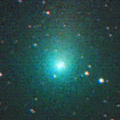
|
It brightened up to 9.5 mag from winter to early spring (Jan. 30, Katsumi Yoshimoto). Now it is 12.3 mag (Aug. 3, Ken-ichi Kadota). It will fade out rapidly after this. It stays observable in good condition.
Date(TT) R.A. (2000) Decl. Delta r Elong. m1 Best Time(A, h)
Aug. 12 0 21.68 24 31.2 2.112 2.777 121 12.1 3:03 ( 0, 80)
Aug. 19 0 10.68 21 56.6 2.071 2.840 131 12.2 2:25 ( 0, 77)
|
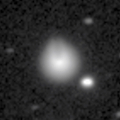
|
It returns for the first time in 70 years. It will brighten up to 4.5 mag in 2024 spring. It suddenly brightened in outburst by 5 mag up to 11.5 mag on July 20 (E. Tamas, Francois Kugel). Now it is 12.4 mag (Aug. 7, Osamu Miyazaki). Fading slowly. In the Northern Hemisphere, it stays observable in good condition. In the Southern Hemisphere, it will be unobservable soon.
Date(TT) R.A. (2000) Decl. Delta r Elong. m1 Best Time(A, h)
Aug. 12 17 44.61 54 47.8 3.403 3.651 96 12.2 20:25 (178, 70)
Aug. 19 17 36.31 54 0.8 3.359 3.577 94 12.4 20:15 (167, 70)
|

|
Now it is 13.7 mag (July 14, Chris Wyatt). It stays 13 mag for a while. In the Northern Hemisphere, it is not observable now, but it will appear in October. In the Southern Hemisphere, it will be unobservable soon. But it will be observable again in September.
Date(TT) R.A. (2000) Decl. Delta r Elong. m1 Best Time(A, h)
Aug. 12 10 27.80 -12 37.1 4.645 3.823 31 12.8 20:25 ( 91,-23)
Aug. 19 10 29.93 -13 38.5 4.704 3.843 28 12.9 20:15 ( 92,-27)
|

|
Now it is 13.0 mag (Aug. 11, Chris Wyatt). Fading slowly. In the Northern Hemisphere, it is not observable now. It was expected to brighten up to 10 mag from spring to summer. However, it is fainter than originally expected.
Date(TT) R.A. (2000) Decl. Delta r Elong. m1 Best Time(A, h)
Aug. 12 11 11.81 -77 45.5 2.972 3.210 94 13.1 20:25 ( 15,-36)
Aug. 19 11 16.34 -76 39.1 3.058 3.231 90 13.2 20:15 ( 16,-37)
|

|
Now it is 12.4 mag (Aug. 11, Chris Wyatt). It will fade out rapidly after this. It will be fainter than 18 mag in December. It stays observable in good condition.
Date(TT) R.A. (2000) Decl. Delta r Elong. m1 Best Time(A, h)
Aug. 12 19 29.47 0 41.2 1.184 2.110 147 13.2 22:07 ( 0, 56)
Aug. 19 19 28.16 0 22.3 1.237 2.129 142 13.4 21:38 ( 0, 55)
|

|
It brightened up to 8.3 mag in 2021-2022 winter (Jan. 6, 2022, Toshiyuki Takahashi). Now it is 13.2 mag (July 14, Chris Wyatt). It stays 14 mag for a while. In the Northern Hemisphere, it is not observable now, but it will appear in November. It locates somewhat low in the Southern Hemisphere. But it will become high in autumn.
Date(TT) R.A. (2000) Decl. Delta r Elong. m1 Best Time(A, h)
Aug. 12 10 7.82 -32 3.5 6.742 6.116 48 13.3 20:25 ( 73,-37)
Aug. 19 10 13.59 -32 36.0 6.821 6.160 45 13.3 20:15 ( 74,-39)
|
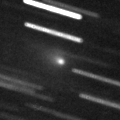
|
Now it is 14.0 mag (July 22, Thomas Lehmann). It will fade out rapidly after this. It will be fainter than 18 mag in November. In the Northern Hemisphere, it will be getting lower gradually. In the Southern Hemisphere, it will be getting higher gradually.
Date(TT) R.A. (2000) Decl. Delta r Elong. m1 Best Time(A, h)
Aug. 12 20 5.32 37 37.6 0.763 1.573 123 13.4 22:40 (180, 88)
Aug. 19 19 36.34 23 37.1 0.767 1.620 130 13.5 21:45 ( 0, 78)
|
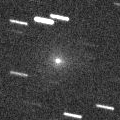
|
It was expected to brighten up to 11 mag in July. But actually, it is fainter than originally expected. Now it is 13.3 mag (July 24, Ken-ichi Kadota). It will fade out rapidly after this. It will be fainter than 18 mag in October. It locates somewhat low in the Northern Hemisphere. It stays extremely low in the Southern Hemisphere.
Date(TT) R.A. (2000) Decl. Delta r Elong. m1 Best Time(A, h)
Aug. 12 7 10.70 16 52.4 1.735 1.030 32 13.5 3:43 (255, 8)
Aug. 19 7 37.05 15 3.3 1.783 1.077 32 13.9 3:51 (258, 9)
|
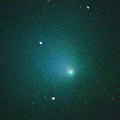
|
It will brighten up to 7.5 mag in October. Now it is 11.7 mag (Aug. 15, Michael Jager). Brightening rapidly. It will be unobservable in September in the Southern Hemisphere, or in October in the Northern Hemisphere.
Date(TT) R.A. (2000) Decl. Delta r Elong. m1 Best Time(A, h)
Aug. 12 4 29.58 31 7.7 1.458 1.439 68 14.6 3:43 (260, 47)
Aug. 19 5 0.01 32 32.6 1.323 1.340 68 13.6 3:51 (258, 48)
|

|
Now it is 13.8 mag (July 21, Ken-ichi Kadota). Fading gradually. In the Northern Hemisphere, it stays observable in good condition. In the Southern Hemisphere, it will be unobservable in September.
Date(TT) R.A. (2000) Decl. Delta r Elong. m1 Best Time(A, h)
Aug. 12 2 35.43 32 3.1 1.403 1.759 92 13.6 3:43 (272, 70)
Aug. 19 2 39.88 36 46.6 1.362 1.779 95 13.6 3:51 (258, 77)
|
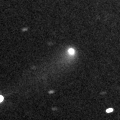
|
Now it is 14.6 mag (July 24, Toshihiko Ikemura, Hirohisa Sato). Fading slowly. It stays observable in good condition.
Date(TT) R.A. (2000) Decl. Delta r Elong. m1 Best Time(A, h)
Aug. 12 2 12.19 7 36.5 2.901 3.315 105 14.0 3:43 (325, 58)
Aug. 19 2 2.07 7 43.7 2.784 3.330 114 13.9 3:51 (347, 62)
|
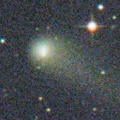
|
It brightened up to 11.1 mag in early 2022 (Mar. 31, 2022, F. Kugel, J.-G. Bosch, J. Nicolas). Now it is 13.9 mag (Aug. 5, Hirohisa Sato). Fading slowly. In the Northern Hemisphere, it stays observable in good condition. In the Southern Hemisphere, it will be getting lower gradually after this, and it will be unobservable in October.
Date(TT) R.A. (2000) Decl. Delta r Elong. m1 Best Time(A, h)
Aug. 12 15 17.65 19 59.8 5.517 5.491 83 14.0 20:25 ( 75, 54)
Aug. 19 15 20.31 19 34.0 5.636 5.525 78 14.0 20:15 ( 78, 51)
|

|
Now it is 13.7 mag (Aug. 11, Jean-Francois Soulier). In the Northern Hemisphere, it will be getting higher gradually. In the Southern Hemisphere, it is not observable now, but it will be observable soon.
Date(TT) R.A. (2000) Decl. Delta r Elong. m1 Best Time(A, h)
Aug. 12 7 56.14 23 33.4 7.050 6.126 22 14.1 3:43 (243, 3)
Aug. 19 8 1.49 23 16.0 7.004 6.128 27 14.1 3:51 (248, 8)
|

|
The ATLAS search program detected its cometary activity in April. It continues to be brightening even after the perihelion passage. Now it is 14.7 mag (Aug. 7, ATLAS Chile). Fading gradually. It locates somewhat low in the Northern Hemisphere. But it will become high in autumn. In the Southern Hemisphere, it stays observable in good condition.
Date(TT) R.A. (2000) Decl. Delta r Elong. m1 Best Time(A, h)
Aug. 12 0 0.83 -26 24.2 2.022 2.889 141 14.4 2:42 ( 0, 29)
Aug. 19 23 59.18 -26 48.4 2.014 2.915 146 14.4 2:13 ( 0, 28)
|

|
Now it is 14.3 mag (July 7, Thomas Lehmann). Fading slowly. In the Northern Hemisphere, it is not observable now. It locates somewhat low in the Southern Hemisphere. But it will become high in winter.
Date(TT) R.A. (2000) Decl. Delta r Elong. m1 Best Time(A, h)
Aug. 12 9 51.54 -46 27.2 2.677 2.375 61 14.5 20:25 ( 56,-43)
Aug. 19 10 17.83 -47 18.0 2.748 2.418 60 14.6 20:15 ( 55,-42)
|
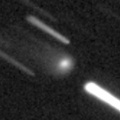
|
Now it is 14.8 mag (Aug. 5, Hirohisa Sato). It stays 15 mag for a while. It will be getting lower gradually after this, and it will be unobservable in October. But it will be observable again in December in the Northern Hemisphere. It is expected to brighten up to 12.5 mag in 2024 spring. At the high light, it will be observable in excellent condition in the Southern Hemisphere, but it will be low in the Northern Hemisphere.
Date(TT) R.A. (2000) Decl. Delta r Elong. m1 Best Time(A, h)
Aug. 12 15 23.07 10 40.4 3.372 3.467 86 14.7 20:25 ( 62, 49)
Aug. 19 15 17.98 8 57.1 3.451 3.424 80 14.7 20:15 ( 66, 44)
|
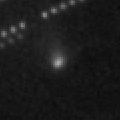
|
It brightened very rapidly. Now it is 15.2 mag (Aug. 3, ATLAS South Africa). It will fade out rapidly after this. It will be fainter than 18 mag in December. It will be unobservable in October in the Southern Hemisphere, or in November in the Northern Hemisphere. But it will be observable again in November in the Northern Hemisphere.
Date(TT) R.A. (2000) Decl. Delta r Elong. m1 Best Time(A, h)
Aug. 12 13 51.70 -37 21.4 1.950 2.065 81 14.7 20:25 ( 43, -1)
Aug. 19 13 52.90 -33 24.5 2.088 2.053 73 14.7 20:15 ( 48, 0)
|

|
It approached to Earth down to 0.29 a.u. in early February, and it brightened up to 4.5 mag (Feb. 1, Juan Jose Gonzalez). Now it is 15.7 mag (Aug. 4, ATLAS Chile). Fading slowly. In the Northern Hemisphere, it is not observable now, but it will appear in September. In the Southern Hemisphere, it stays observable in good condition.
Date(TT) R.A. (2000) Decl. Delta r Elong. m1 Best Time(A, h)
Aug. 12 6 32.48 -31 34.1 3.501 3.161 62 14.7 3:43 (300,-12)
Aug. 19 6 35.50 -33 43.6 3.516 3.238 65 14.8 3:51 (306, -8)
|

|
Now it is 14.6 mag (Aug. 5, J. L. Virlichie, P. Traverse, H. Roy, G. Houdin). Fading slowly. It locates somewhat low in the Northern Hemisphere. In the Southern Hemisphere, it stays observable in good condition.
Date(TT) R.A. (2000) Decl. Delta r Elong. m1 Best Time(A, h)
Aug. 12 17 52.71 -30 41.1 2.161 2.910 129 14.8 20:31 ( 0, 24)
Aug. 19 17 53.34 -31 21.5 2.237 2.911 122 14.9 20:15 ( 3, 24)
|
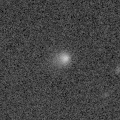
|
Now it is 15.6 mag (July 8, Thomas Lehmann). Brightening slowly. Now it is not observable. It will appear in September. It is expected to brighten up to 12 mag from 2024 to 2025.
Date(TT) R.A. (2000) Decl. Delta r Elong. m1 Best Time(A, h)
Aug. 12 9 18.11 3 7.2 6.037 5.051 12 14.9 3:43 (246,-25)
Aug. 19 9 21.16 3 18.4 5.996 5.011 12 14.8 3:51 (252,-19)
|

|
It will approach to Earth down to 0.2 a.u. in November, and it is expected to brighten up to 7.5 mag. Now it is 14.5 mag (Aug. 14, Michael Jager). Brightening rapidly. It locates somewhat low in the Northern Hemisphere. But it will become high in autumn. In the Southern Hemisphere, it is not observable now, but it will appear in November.
Date(TT) R.A. (2000) Decl. Delta r Elong. m1 Best Time(A, h)
Aug. 12 11 35.89 43 39.0 2.241 1.601 39 15.3 20:25 (129, 21)
Aug. 19 11 37.09 43 26.5 2.175 1.512 38 15.0 20:15 (130, 19)
|

|
Now it is 15.7 mag (Aug. 1, ATLAS Chile). Fading gradually. It locates somewhat low in the Northern Hemisphere. In the Southern Hemisphere, it stays observable in good condition.
Date(TT) R.A. (2000) Decl. Delta r Elong. m1 Best Time(A, h)
Aug. 12 17 0.20 -19 58.8 2.036 2.657 117 15.0 20:25 ( 13, 34)
Aug. 19 17 3.88 -20 15.9 2.159 2.697 111 15.3 20:15 ( 17, 33)
|

|
It will brighten up to 14 mag from 2024 to 2025. Now it is 15.2 mag (July 22, ATLAS Chile). It stays 15 mag for a while. In the Northern Hemisphere, it is not observable now, but it will appear in October. It stays extremely low in the Southern Hemisphere. But it will become high in autumn.
Date(TT) R.A. (2000) Decl. Delta r Elong. m1 Best Time(A, h)
Aug. 12 10 5.77 -26 59.1 6.509 5.814 43 15.2 20:25 ( 79,-35)
Aug. 19 10 12.69 -27 9.5 6.519 5.787 40 15.2 20:15 ( 80,-37)
|
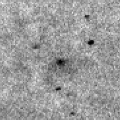
|
It brightened up to 12.8 mag in spring (Mar. 8, Taras Prystavski). Now it is 15.5 mag (July 23, Thomas Lehmann). Fading gradually. It will be fainter than 18 mag in December. It stays observable in good condition.
Date(TT) R.A. (2000) Decl. Delta r Elong. m1 Best Time(A, h)
Aug. 12 1 34.87 -2 18.4 1.729 2.369 117 15.3 3:43 (347, 52)
Aug. 19 1 34.60 -2 33.9 1.693 2.407 123 15.4 3:48 ( 0, 53)
|

|
It has not been observed yet in this apparition. It was expected to brighten rapidly up to 15 mag in summer. But actually, it is not detected, fainter than 19 mag (Aug. 12, Martin Masek). It stays 16 mag for a while. It locates somewhat low in the Northern Hemisphere. In the Southern Hemisphere, it stays observable in good condition.
Date(TT) R.A. (2000) Decl. Delta r Elong. m1 Best Time(A, h)
Aug. 12 16 49.97 -30 15.8 1.452 2.102 115 15.3 20:25 ( 13, 23)
Aug. 19 16 56.13 -29 30.8 1.503 2.085 110 15.3 20:15 ( 16, 24)
|

|
Now it is 15.6 mag (Aug. 11, ATLAS South Africa). It stays 16 mag for a while. It stays observable in good condition.
Date(TT) R.A. (2000) Decl. Delta r Elong. m1 Best Time(A, h)
Aug. 12 0 48.96 -5 18.1 2.845 3.570 128 15.8 3:30 ( 0, 50)
Aug. 19 0 47.58 -5 36.3 2.789 3.585 135 15.8 3:01 ( 0, 50)
|
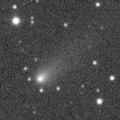
|
Now it is 15.9 mag (Aug. 2, ATLAS South Africa). Fading gradually. It will be fainter than 18 mag in December. In the Northern Hemisphere, it will be unobservable in September. In the Southern Hemisphere, it stays observable in good condition.
Date(TT) R.A. (2000) Decl. Delta r Elong. m1 Best Time(A, h)
Aug. 12 14 13.20 -35 59.1 2.374 2.500 85 15.8 20:25 ( 40, 3)
Aug. 19 14 24.04 -36 33.8 2.466 2.516 81 16.0 20:15 ( 41, 2)
|

|
It will approach to Sun down to 0.4 a.u. in late September in 2024, and it is expected to brighten up to 0 mag. Now it is 16.0 mag (Aug. 7, ATLAS South Africa). Brightening slowly. It will be unobservable in October. But it will be observable again in November in the Northern Hemisphere. At the high light, in the Northern Hemisphere, it will be observable in good condition after the perihelion passage. In the Southern Hemisphere, it will be observable in the low sky before and after the perihelion passage.
Date(TT) R.A. (2000) Decl. Delta r Elong. m1 Best Time(A, h)
Aug. 12 14 2.98 1 26.0 6.003 5.735 69 16.0 20:25 ( 70, 28)
Aug. 19 14 3.34 1 1.1 6.043 5.666 63 15.9 20:15 ( 73, 24)
|
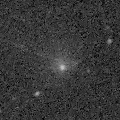
|
Very large comet. It is expected to brighten up to 13 mag in 2031. Now it is 15.9 mag (July 23, Thomas Lehmann). It stays 16 mag for a while. In the Northern Hemisphere, it is not observable now. In the Southern Hemisphere, it stays observable in good condition. In the Northern Hemisphere, it is not observable until 2030.
Date(TT) R.A. (2000) Decl. Delta r Elong. m1 Best Time(A, h)
Aug. 12 3 32.42 -61 11.8 17.106 17.351 102 16.3 3:43 (343,-11)
Aug. 19 3 33.27 -61 39.9 17.062 17.326 103 16.3 3:51 (347, -9)
|
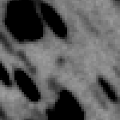
|
Now it is 16.7 mag (Aug. 3, Ken-ichi Kadota). It stays 17 mag for a while. It stays observable in good condition.
Date(TT) R.A. (2000) Decl. Delta r Elong. m1 Best Time(A, h)
Aug. 12 17 41.93 -10 38.2 1.921 2.644 125 16.6 20:25 ( 2, 44)
Aug. 19 17 42.58 -10 48.3 1.976 2.625 119 16.6 20:15 ( 7, 44)
|

|
It is expected to brighten up to 14 mag in winter. Now it is 17.8 mag (Aug. 3, Ken-ichi Kadota). Brightening gradually. It stays observable in good condition.
Date(TT) R.A. (2000) Decl. Delta r Elong. m1 Best Time(A, h)
Aug. 12 3 6.46 12 23.3 2.728 2.928 91 16.8 3:43 (301, 54)
Aug. 19 3 12.48 12 52.4 2.600 2.890 96 16.6 3:51 (310, 59)
|
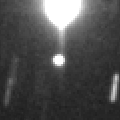
|
Now it is 16.0 mag (Aug. 11, ATLAS South Africa). Fading gradually. It will be fainter than 18 mag in October. It stays observable in good condition. It was very faint as 21.5 mag in 2021. It seems to be bright temporarily in outburst.
Date(TT) R.A. (2000) Decl. Delta r Elong. m1 Best Time(A, h)
Aug. 12 21 26.47 -10 52.5 3.455 4.467 175 16.7 0:08 ( 0, 44)
Aug. 19 21 22.57 -11 4.3 3.474 4.480 172 16.8 23:32 ( 0, 44)
|

|
It brightened up to 13.4 mag in last summer (July 7, 2022, Giuseppe Pappa). Now it is 16.6 mag (Aug. 5, Hirohisa Sato). Fading slowly. In the Northern Hemisphere, it stays observable in good condition. In the Southern Hemisphere, it will be unobservable in October.
Date(TT) R.A. (2000) Decl. Delta r Elong. m1 Best Time(A, h)
Aug. 12 15 21.48 32 23.2 4.372 4.335 81 16.7 20:25 ( 95, 60)
Aug. 19 15 19.97 31 54.1 4.502 4.381 76 16.8 20:15 ( 97, 56)
|

|
Very far object. Now it is 17.3 mag (July 23, ATLAS South Africa). It stays 17 mag for a while. In the Northern Hemisphere, it is not observable now. In the Southern Hemisphere, it stays observable in good condition.
Date(TT) R.A. (2000) Decl. Delta r Elong. m1 Best Time(A, h)
Aug. 12 5 47.85 -69 50.9 10.223 10.326 92 16.8 3:43 (339,-27)
Aug. 19 5 48.89 -70 26.8 10.222 10.324 92 16.8 3:51 (341,-24)
|

|
It brightened up to 14.1 mag in 2022 spring (Mar. 22, 2022, Chris Wyatt). It was expected to brighten up to 13 mag. But actually, it was fainter than originally expected. Now it is 16.4 mag (Aug. 5, ATLAS South Africa). It stays 17 mag for a while. It stays observable in good condition.
Date(TT) R.A. (2000) Decl. Delta r Elong. m1 Best Time(A, h)
Aug. 12 3 3.55 -2 40.1 4.779 4.984 95 16.9 3:43 (316, 43)
Aug. 19 3 1.11 -2 36.0 4.710 5.031 102 16.9 3:51 (328, 48)
|

|
It is expected to brighten up to 14 mag in 2024 summer. At the high light, it is not observable in the Northern Hemisphere. Now it is 17.6 mag (Aug. 11, ATLAS South Africa). Brightening slowly. It stays observable in good condition.
Date(TT) R.A. (2000) Decl. Delta r Elong. m1 Best Time(A, h)
Aug. 12 3 29.98 4 27.2 4.277 4.353 87 17.0 3:43 (303, 44)
Aug. 19 3 31.26 3 11.7 4.112 4.304 94 16.9 3:51 (314, 49)
|

|
Now it is 16.2 mag (Aug. 6, Jean-Claude Merlin). It stays 17 mag for a while. It will be unobservable in October in the Northern Hemisphere, or in December in the Southern Hemisphere. It stays 16 mag in the Southern sky for a long time from 2024 to 2025.
Date(TT) R.A. (2000) Decl. Delta r Elong. m1 Best Time(A, h)
Aug. 12 16 40.86 -40 40.1 6.073 6.554 114 17.1 20:25 ( 13, 13)
Aug. 19 16 36.06 -40 28.1 6.157 6.524 106 17.1 20:15 ( 17, 12)
|

|
It returns for the first time in 68 years. It will brighten up to 7.5 mag in 2024 summer. It has not been observed yet in this apparition. It will brighten rapidly after this. In the Southern Hemisphere, it stays observable in good condition. At the high light, it locates low in the Northern Hemisphere, or it is not observable in the Southern Hemisphere.
Date(TT) R.A. (2000) Decl. Delta r Elong. m1 Best Time(A, h)
Aug. 12 4 13.58 -14 16.8 4.139 4.127 82 17.3 3:43 (309, 23)
Aug. 19 4 17.54 -14 37.5 3.987 4.062 86 17.1 3:51 (315, 28)
|
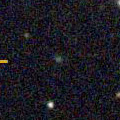
|
Now it is 17.7 mag (Aug. 3, ATLAS-HKO, Haleakala). It stays 17 mag for a while. In the Northern Hemisphere, it stays observable in good condition. It stays extremely low in the Southern Hemisphere.
Date(TT) R.A. (2000) Decl. Delta r Elong. m1 Best Time(A, h)
Aug. 12 4 41.76 36 52.9 7.109 6.755 65 17.2 3:43 (251, 46)
Aug. 19 4 45.94 37 16.9 7.005 6.748 71 17.2 3:51 (252, 52)
|

|
Now it is 17.3 mag (Aug. 5, ATLAS South Africa). It stays 17 mag for a while. In the Northern Hemisphere, it will be getting higher gradually. In the Southern Hemisphere, it stays observable in good condition.
Date(TT) R.A. (2000) Decl. Delta r Elong. m1 Best Time(A, h)
Aug. 12 4 47.98 -9 16.9 7.939 7.700 72 17.4 3:43 (298, 21)
Aug. 19 4 50.65 -9 28.5 7.816 7.667 77 17.3 3:51 (305, 26)
|
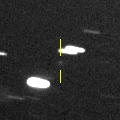
|
First return of a new periodic comet which brightened up to 15 mag in 2008. Now it is 17.4 mag (Aug. 3, Ken-ichi Kadota). Fading slowly. It will be fainter than 18 mag in November. It stays observable in good condition.
Date(TT) R.A. (2000) Decl. Delta r Elong. m1 Best Time(A, h)
Aug. 12 3 30.80 22 15.2 2.382 2.471 82 17.4 3:43 (281, 55)
Aug. 19 3 39.56 21 49.1 2.317 2.492 87 17.4 3:51 (288, 60)
|

|
Now it is 17.6 mag (Aug. 7, Hirohisa Sato). It stays 18 mag for a while. In the Northern Hemisphere, it stays observable in good condition. It stays extremely low in the Southern Hemisphere.
Date(TT) R.A. (2000) Decl. Delta r Elong. m1 Best Time(A, h)
Aug. 12 14 23.09 36 44.8 3.108 2.900 68 17.5 20:25 (107, 49)
Aug. 19 14 33.92 34 43.6 3.146 2.902 66 17.6 20:15 (105, 47)
|

|
It will brighten rapidly after this. It will be unobservable in October.
Date(TT) R.A. (2000) Decl. Delta r Elong. m1 Best Time(A, h)
Aug. 12 6 39.90 26 52.0 2.058 1.437 39 17.9 3:43 (250, 19)
Aug. 19 7 0.95 26 0.1 1.924 1.351 41 17.7 3:51 (253, 22)
|

|
Now it is 17.8 mag (Aug. 11, W. Hasubick). It stays 18 mag for a while. It stays observable in good condition.
Date(TT) R.A. (2000) Decl. Delta r Elong. m1 Best Time(A, h)
Aug. 12 3 33.83 9 3.1 2.896 2.991 85 17.7 3:43 (298, 47)
Aug. 19 3 40.07 9 0.1 2.813 2.999 90 17.7 3:51 (305, 52)
|

|
It brightened up to 13.6 mag in 2021 (June 17, 2021, R. Carstens). Now it is 17.3 mag (June 9, D. Husar, M. Junius, S. Messner). It stays 18 mag for a while. In the Northern Hemisphere, it will never be observable after this.
Date(TT) R.A. (2000) Decl. Delta r Elong. m1 Best Time(A, h)
Aug. 12 11 9.32 -60 19.1 7.073 6.941 78 17.7 20:25 ( 36,-34)
Aug. 19 11 12.41 -60 5.9 7.169 6.975 74 17.8 20:15 ( 37,-36)
|

|
It approached to Earth down to 0.12 a.u. in April, and brightened up to 11.5 mag (Apr. 8, Osamu Miyazaki). Now it is 17.9 mag (Aug. 12, J. Nicolas, F. Kugel). It will fade out rapidly after this. It will be fainter than 18 mag soon. It stays observable in good condition.
Date(TT) R.A. (2000) Decl. Delta r Elong. m1 Best Time(A, h)
Aug. 12 2 40.94 0 21.7 0.983 1.535 100 17.8 3:43 (321, 48)
Aug. 19 2 39.01 0 15.2 0.982 1.608 107 18.1 3:51 (334, 52)
|
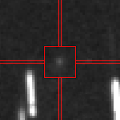
|
Now it is 18.0 mag (July 28, Ken-ichi Kadota). Fading slowly. It will be fainter than 18 mag in October. It stays observable in good condition.
Date(TT) R.A. (2000) Decl. Delta r Elong. m1 Best Time(A, h)
Aug. 12 23 8.96 -12 51.4 2.093 3.040 154 17.8 1:50 ( 0, 42)
Aug. 19 23 6.16 -13 53.2 2.065 3.043 161 17.8 1:20 ( 0, 41)
|
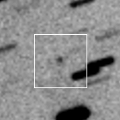
|
Now it is 17.6 mag (July 29, ATLAS-HKO, Haleakala). It stays 18 mag for a while. In the Northern Hemisphere, it stays observable in good condition. In the Southern Hemisphere, it will be unobservable in September.
Date(TT) R.A. (2000) Decl. Delta r Elong. m1 Best Time(A, h)
Aug. 12 2 51.04 51 14.7 4.613 4.607 83 18.0 3:43 (222, 64)
Aug. 19 2 44.82 52 33.7 4.481 4.583 89 17.9 3:51 (209, 69)
|
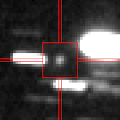
|
It is expected to brighten up to 13 mag from summer to autumn in 2024. Now it is 17.3 mag (July 28, ATLAS South Africa). Brightening slowly. In the Northern Hemisphere, it is not observable now. It locates somewhat low in the Southern Hemisphere. But it will become high in winter.
Date(TT) R.A. (2000) Decl. Delta r Elong. m1 Best Time(A, h)
Aug. 12 10 59.91 -41 27.4 5.654 5.235 60 18.0 20:25 ( 58,-30)
Aug. 19 11 6.99 -41 42.4 5.653 5.180 57 17.9 20:15 ( 59,-32)
|

|
Now it is 18.8 mag (Feb. 17, Toshihiko Ikemura, Hirohisa Sato). Brightening slowly. In the Northern Hemisphere, it stays observable in good condition. It stays extremely low in the Southern Hemisphere.
Date(TT) R.A. (2000) Decl. Delta r Elong. m1 Best Time(A, h)
Aug. 12 4 42.47 38 53.2 5.884 5.541 65 18.0 3:43 (248, 46)
Aug. 19 4 47.81 38 58.4 5.763 5.515 70 17.9 3:51 (249, 52)
|

|
Now it is 17.1 mag (Aug. 4, ATLAS-HKO, Haleakala). It stays 18 mag for a while. In the Northern Hemisphere, it stays observable in good condition. In the Southern Hemisphere, it will never be observable after this.
Date(TT) R.A. (2000) Decl. Delta r Elong. m1 Best Time(A, h)
Aug. 12 14 36.21 76 35.3 10.437 10.177 72 17.9 20:25 (166, 43)
Aug. 19 14 33.95 76 0.1 10.450 10.196 72 18.0 20:15 (165, 43)
|

|
It has not been observed yet in this apparition. It tends to brighten after the perihelion passage. Brightening slowly. In the Northern Hemisphere, it is not observable now. In the Southern Hemisphere, it will be unobservable in October.
Date(TT) R.A. (2000) Decl. Delta r Elong. m1 Best Time(A, h)
Aug. 12 11 7.75 6 25.3 2.193 1.367 26 18.4 20:25 (101, -4)
Aug. 19 11 30.19 4 24.0 2.191 1.356 25 18.0 20:15 ( 98, -4)
|
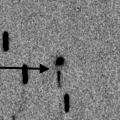
|
David Rankin detected its cometary activity in June. Now it is 16.8 mag (Aug. 10, Katsumi Yoshimoto). It stays 19 mag for a while. It stays observable in good condition. It is brighter than this ephemeris recently.
Date(TT) R.A. (2000) Decl. Delta r Elong. m1 Best Time(A, h)
Aug. 12 22 29.55 -3 11.5 1.459 2.436 159 18.5 1:11 ( 0, 52)
Aug. 19 22 26.10 -3 10.0 1.410 2.407 166 18.3 0:40 ( 0, 52)
|
|
![]()
 103P/Hartley 2
103P/Hartley 2 C/2017 K2 ( PanSTARRS )
C/2017 K2 ( PanSTARRS ) C/2021 S3 ( PanSTARRS )
C/2021 S3 ( PanSTARRS ) C/2022 A2 ( PanSTARRS )
C/2022 A2 ( PanSTARRS ) 12P/Pons-Brooks
12P/Pons-Brooks C/2019 U5 ( PanSTARRS )
C/2019 U5 ( PanSTARRS ) C/2020 K1 ( PanSTARRS )
C/2020 K1 ( PanSTARRS ) 237P/LINEAR
237P/LINEAR C/2019 L3 ( ATLAS )
C/2019 L3 ( ATLAS ) C/2022 W3 ( Leonard )
C/2022 W3 ( Leonard ) 185P/Petriew
185P/Petriew 2P/Encke
2P/Encke 126P/IRAS
126P/IRAS C/2021 X1 ( Maury-Attard )
C/2021 X1 ( Maury-Attard ) C/2019 T4 ( ATLAS )
C/2019 T4 ( ATLAS ) 29P/Schwassmann-Wachmann 1
29P/Schwassmann-Wachmann 1 C/2022 JK5 ( PanSTARRS )
C/2022 JK5 ( PanSTARRS ) C/2021 Y1 ( ATLAS )
C/2021 Y1 ( ATLAS ) C/2022 L2 ( ATLAS )
C/2022 L2 ( ATLAS ) C/2023 K1 ( ATLAS )
C/2023 K1 ( ATLAS ) C/2022 E3 ( ZTF )
C/2022 E3 ( ZTF ) 199P/Shoemaker 4
199P/Shoemaker 4 C/2022 E2 ( ATLAS )
C/2022 E2 ( ATLAS ) C/2023 H2 ( Lemmon )
C/2023 H2 ( Lemmon ) 81P/Wild 2
81P/Wild 2 C/2021 G2 ( ATLAS )
C/2021 G2 ( ATLAS ) 71P/Clark
71P/Clark 213P/Van Ness
213P/Van Ness 117P/Helin-Roman-Alu 1
117P/Helin-Roman-Alu 1 77P/Longmore
77P/Longmore C/2023 A3 ( Tsuchinshan-ATLAS )
C/2023 A3 ( Tsuchinshan-ATLAS ) C/2014 UN271 ( Bernardinelli-Bernstein )
C/2014 UN271 ( Bernardinelli-Bernstein ) 219P/LINEAR
219P/LINEAR 32P/Comas Sola
32P/Comas Sola P/2023 M4 ( ATLAS )
P/2023 M4 ( ATLAS ) C/2020 R7 ( ATLAS )
C/2020 R7 ( ATLAS ) C/2019 E3 ( ATLAS )
C/2019 E3 ( ATLAS ) C/2020 Y2 ( ATLAS )
C/2020 Y2 ( ATLAS ) C/2022 S4 ( Lemmon )
C/2022 S4 ( Lemmon ) C/2023 F3 ( ATLAS )
C/2023 F3 ( ATLAS ) 13P/Olbers
13P/Olbers C/2021 S4 ( Tsuchinshan )
C/2021 S4 ( Tsuchinshan ) C/2022 QE78 ( ATLAS )
C/2022 QE78 ( ATLAS ) 465P/2023 L1 ( Hill )
465P/2023 L1 ( Hill ) C/2022 U4 ( Bok )
C/2022 U4 ( Bok ) (3200) Phaethon
(3200) Phaethon 170P/Christensen
170P/Christensen C/2018 U1 ( Lemmon )
C/2018 U1 ( Lemmon ) 364P/PanSTARRS
364P/PanSTARRS 287P/Christensen
287P/Christensen C/2022 U1 ( Leonard )
C/2022 U1 ( Leonard ) C/2023 C2 ( ATLAS )
C/2023 C2 ( ATLAS ) C/2022 U3 ( Bok )
C/2022 U3 ( Bok ) C/2019 O3 ( Palomar )
C/2019 O3 ( Palomar ) 339P/Gibbs
339P/Gibbs 2023 KF3
2023 KF3![]()






















































